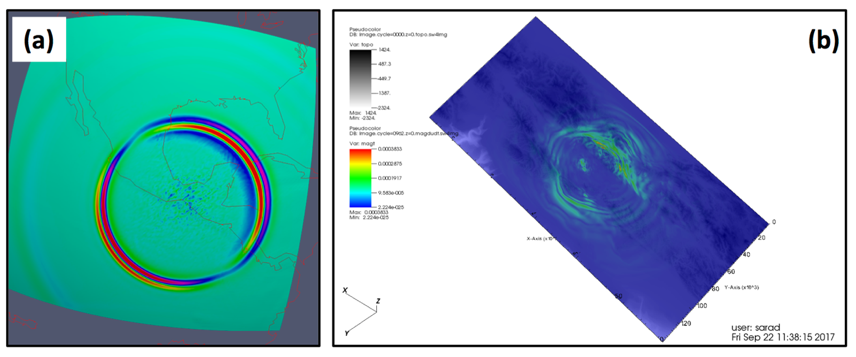2017 CIG-LLNL Computational Seismology Workshop
Joint CIG-LLNL Computational Seismology Workshop Trains Early Career Scientists
The Computational Infrastructure for Geodynamics (CIG) in collaboration with Lawrence Livermore National Laboratory (LLNL) held a workshop focusing on computational seismology at the Livermore Valley Open Campus September 18-22, 2017. The workshop provided training on seismic waveform processing, visualization and high-performance computing (HPC) waveform simulation. Fifty-five (55) predominantly early career (graduate student and postdoc) participants from the US and 16 countries attended. The workshop was the first of its kind to feature full access to HPC resources for research-grade example problems.
Seismic data processing software and numerical codes for HPC simulation of the seismic wavefield have evolved substantially in recent years. The volume of seismic data has greatly increased as instrumentation and technology have advanced and barriers to deploying sensors and transmitting data have fallen. Capabilities for HPC simulation of seismic waves in realistic three-dimensional Earth models have greatly increased for source and Earth structure studies driven by advances in numerical methods and inexorable increases in computing power. HPC simulation of seismic waves will become more common in research and seismic network operations.
The 5-day workshop had several elements. The main objective was practical hands-on tutorials on the workflow involved in simulating seismic waveforms. Keynote lectures by leading researchers described how seismic simulations are advancing understanding of earthquake hazards and Earth structure and they outlined challenges that must be overcome for HPC simulations to gain broader impact. Participants shared their current work in poster and lightning talk sessions.
The workshop tutorials gave participants hands-on experience using four open-source codes for waveform processing and simulation. ObsPy is a Python-based software package for accessing, processing, and visualizing seismic waveforms, event data and metadata. Three methods for computing synthetic seismograms were covered. InstaSeis computes seismograms for radially symmetric models and runs on a laptop. Two codes compute seismograms in three-dimensional Earth models on parallel computers: SW4, a Cartesian finite difference code developed at LLNL; and SPECFEM3D, a spectral element code developed by a large team led by Princeton University. Participants learned how to run these codes, and then processed and visualized the results. LLNL provided access to 7200 cores of the Quartz HPC cluster for 3 days during the workshop, enabling participants to simultaneously run simulations on 100s of processors. During the workshop, the 2017/09/19 magnitude 7.1 Mexico earthquake occurred. Participants ran a simulation of this and other earthquakes with SPECFEM3D, and visualized the results (Figure 1) to exercise their newly acquired skills.
The workshop was sponsored by the CIG, an NSF-funded Geoinformatics project to develop, disseminate, and maintain numerical codes for geodynamics. The Seismological Society of America also provided support. LLNL provided the venue, local organization and HPC cycles.
submitted to EOS
Arthur Rodgers, Lorraine J. Hwang, and Louise H. Kellogg

Figure 1
Visualizations of seismic simulations created by participants and run at the CIG-LLNL Computational Seismology Workshop: (a) SPECFEM3D_GLOBE simulation of the 2018/09/19 M 7.1 Mexico earthquake visualized with Paraview (Kelvin Tian, Columbia University); and (b) SW4 simulation of the 2007/07/20 M 4.0 Piedmont earthquake visualized with Visit (Sara Doherty, USGS).
